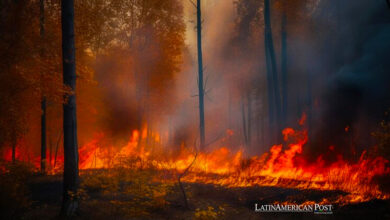Why is Latin America So Vulnerable To Earthquakes?
The regions of Central America and South America have a high probability of earthquakes due to the characteristics of the territory.

Photo: Wikimedia-AntoFran
LatinAmerican Post | María Fernanda Ramírez Ramos
Escucha este artículo
Leer en español: ¿Por qué Latinoamérica es tan vulnerable a los terremotos?
A strong tremor shook Mexico on September 19. The Mexican National Seismological Service announced that it was a magnitude 7.7 earthquake. The strong tremor occurred in the midst of the commemoration of two other earthquakes that occurred in 2017 and 1985, which left hundreds dead. On this occasion, there were two deaths. Also, the phenomenon happened just when a drill was scheduled, so there was confusion in the population. It is not the first time that Mexico has experienced an earthquake of this magnitude. However, this time the loss of life was less and there was more preparation.
However, Mexico is not the only country where earthquakes cause emergencies from time to time. It is worth remembering the earthquake in Haiti in 2010, which caused an unprecedented crisis. In Chile, in 1960 an earthquake of magnitude 9.5 left more than 2 thousand dead. More recently, in 2010, in this Andean country, there was an earthquake that lasted more than 4 minutes. On the other hand, in 1970 in Peru there were more than 66,000 deaths from an earthquake, and six years later, in Guatemala, more than 23,000 deaths.
Why are earthquakes so prevalent in Latin America?
Latin America and the Caribbean is the second region most prone to natural disasters, according to a United Nations report published in 2020. According to this same report, there were 75 earthquakes in the region, with 226,000 deaths and 339,000 injuries, from 2000 to 2020. In particular, the areas of Central America and the western coast of South America are among the most seismic in the world. This is because they are located in the "Ring of Fire", a region characterized by the high presence of volcanoes and constant movements in the tectonic plates.
Central America also has the particularity that two tectonic plates converge in its area: the Caribbean and the North American. That makes it also a very seismic area.
Ecuador, Chile, Mexico, Peru, Guatemala, Costa Rica, Nicaragua, and El Salvador are some of the most vulnerable countries. However, no one is exempt from experiencing an earthquake. Likewise, science has not managed to develop systems that make an exact prediction of earthquakes. For this reason, the best way to deal with them is to be prepared on how to react in case of experiencing one, especially when living in an area with high seismic risk.
Also read: Which are the Latin American Countries Entering the Space Race?
In government matters, countries with seismic risk must have strict construction protocols, which allow buildings to withstand telluric movements. In this sense, regional planning offices and entities for risk prevention must also provide information to the general population about emergency plans in the event of a natural disaster. For example, after the disastrous events in Chile, its anti-seismic construction policies became increasingly strict.
Keys to be prepared for an earthquake
It is important to participate in the drills carried out in your city or workplace. Also, take advantage of the training given in this area. On the other hand, before purchasing a home it is essential to find out about building licenses and adaptation to this type of risk.
"Do not hang heavy objects such as pictures or mirrors near beds, sofas, and places to sit or sleep," says information from the Red Cross. Likewise, in each house there should be an emergency kit, in an easy-to-reach place, that can be used in the event of a catastrophe. This type of kit is useful for different types of disasters or emergencies. A basic emergency kit should contain drinking water, canned or non-perishable food, a flashlight, a battery-powered radio, a first-aid kit, a whistle to call for help, and basic toiletries, as well as a change of clothing if necessary.




